GatewayGardener





















FFounded in 2005 by
Joyce Bruno & Robert Weaver Publisher and Editor Robert WeaverColumnists
Abby Lapides
Sugar Creek Gardens
Steffie Littlefield Edg-Clif Winery
Scott Woodbury
Cacalia Native Garden Design and Wilding
Samantha Zale Greenscape Gardens
Printing: Breese Publishing, Breese, IL
The Gateway Gardener® is published 7 times/year by Double Dig Communications, Inc. to promote enjoyable, successful gardening and livable landscapes in the St. Louis greater metropolitan area. The magazine is distributed free to the public at designated garden centers, nurseries, garden gift shops, lawn equipment rental, repair and sales establishments, and other locations supporting sound gardening, lawn and landscaping practices.
Please send letters-to-the-editor, questions, event announcements, editorial suggestions and contributions, photos, advertising inquiries and materials, and any other correspondence to:
The Gateway Gardener Magazine®
PO Box 220853
St. Louis, MO 63122
Phone: (314) 968-3740
info@gatewaygardener.com
www.gatewaygardener.com
or years, as a magazine publishing member of the Garden Writers Association (now Garden Communicators International, or GardenComm), I was the beneficiary of annual offers of free plants to trial and (the senders would hope) write about. I long ago quit accepting these offers for lack of room, but there was a time when I gratefully welcomed any and all contributions to the cause. It seems for many years these goody boxes would unfailingly include one of the latest of the ever-improving hydrangea offerings. I would find a suitable home for it, and all these years later, it takes the fingers on both hands to tally up the varieties of hydrangeas now dotting my landscape (all one offs except for the natives I added). I have lace caps (my favorite), panicles, mega-balls. I have pinks and blues and whites and greens. I even have the climbing hydrangea (pictured behind me). And I like them all! They are pretty bulletproof, as long as you get the pruning down. One even got uprooted when a nearby tree blew over a few years back. Stuck it

back it the ground and it’s still going strong. They fill the garden with interest for most of the year, either with blooms coming on, at peak (for weeks!) or in the fading pinkish stages before finally contributing their dried brown globes and panicles to the winter landscape. So what’s not to like about hydrangeas? Abby Lapides gives us an update on her current favorites on page 4.
We have some new voices and new topics to offer this month. Sidestepping our normal purview of blossoms and buds, a couple of St. Louis Master Gardeners take us into the world of birds ‘n bugs. On page 14, MG Shawn Pohlman details for us how bird song can not only be a delight to our ears, but can uplift our mental health as well. Accompanying

The world of hydrangeas is vast! Beginning in late spring with big-leaf mop tops and lace caps and progressing through summer into fall, hydrangeas give a big bang for the gardening buck! Abby Lapides explores the latest offerings, such as Hydrangea ‘Popstar’ here, beginning on page 4. Photo courtesy Bailey Nursery.
her article we are delighted to include images from longtime Gateway Gardener friend Margy Terpstra. Juxtaposing the beauty of bird song, Master Gardener Ronda Anson warns on page 20 about the upcoming cicada invasion that may be bugging us all this summer (if it hasn’t already started). Ronda also combines the worlds of birds and bugs on page 11 to answer a gardener’s question about the difference between regularly vs. randomly spaced holes in her trees. We hope we’ll hear more from both these guests in issues to come.
Of course our regular contributors Samantha and Scott and Steffie have also been busy compiling their contributions to the betterment of our gardening knowledge, and we’re happy to share their wisdom with you in this Mother’s Day edition. And with that, I wish a happy Mother’s Day to all!

Going Wild with
What to Plant?
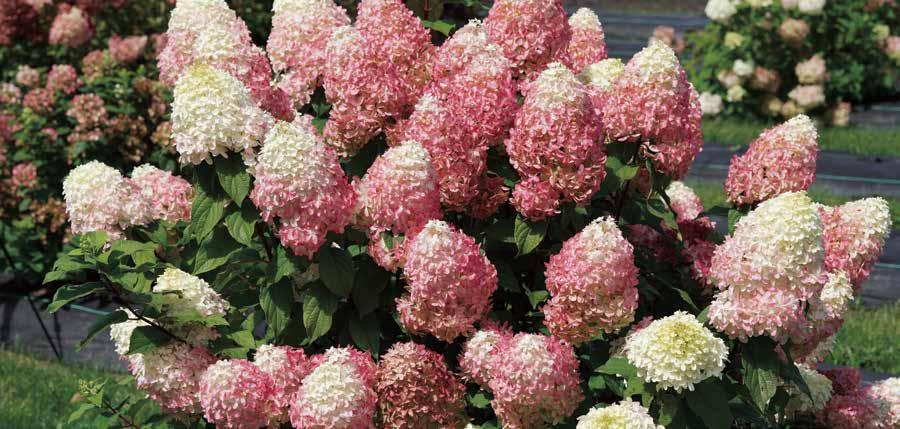
With their over-the-top blossoms and stunning forms, Hydrangeas dominate the garden when flowering. The pillowy blossoms are adored by pollinators and gardeners alike. With the advances in breeding, it can be hard to keep track of all the Hydrangeas available today. Continue reading to learn about which ones thrive in St. Louis to give you the flowers of your dreams.

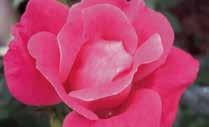


Not many people know that Missouri has a native hydrangea. The smooth hydrangea, Hydrangea arborescens, a stunning native shrub with pollen-heavy lace cap style flowers, bloom for months in the summer. These rugged beauties reliably bloom every year and are tolerant of many different soil conditions and light exposures. With their showy flowers and refined form, they




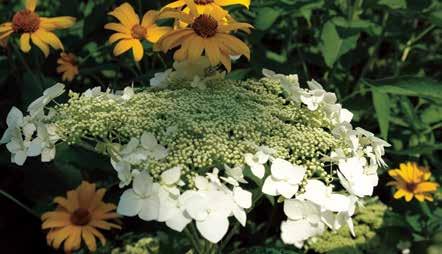


integrate into a variety of locations including woodland plantings or for more formal settings. Cultivars of the native hydrangeas include the extremely popular ‘Incrediball’ Hydrangea, the mini ‘Wee White’, the pink variety ‘Invincibelle Ruby’, and the stunning ‘Haas Halo’.
The last of the hydrangeas to flower, Hydrangea paniculata, or panicle hydrangeas, give a huge show mid-summer when many other plants are beginning to tire out. These are also the only hydrangeas that thrive in the sun. The large, bullet-shaped blossoms all start out a limey green before turning white, finally ending in pink. Coming in all different sizes, ‘Early Evolution’ maxes out at 2’ tall, while ‘Quick Fire Fab’ can get a whopping 8’. The key for best flower color is to keep them well-watered from when they begin to bud until frost.
All smooth hydrangeas and panicle hydrangeas bloom on new






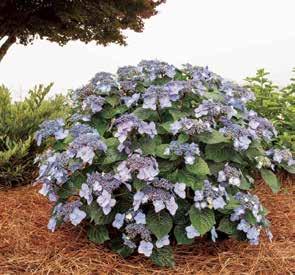
wood and may be pruned up until May when they start to set up their flower buds. Prune to about knee-height.
Between the rough winters and late frosts, many Hydrangea macrophyllas are duds in the garden. Mostly blooming exclusively on old wood, they will suffer from winter die-back or
on next page
Abby Lapides is owner and a speaker at Sugar Creek Gardens Nursery. She has degrees from the University of Missouri, and is a member of the Landscape and Nursery Association of Greater St. Louis. You can reach her at (314) 965-3070.



the buds will get zapped by a late frost. Fortunately, some brilliant breeding has occurred in the last 10 years, and the newer releases of these hydrangeas now offer superior budding and blooming. Newer varieties are much more cold hardy and develop flower buds at the crown of the plant. This keeps the buds protected from cold snaps to ensure they flower every year. Not only that, but they also repeat flower quicker and with more blossoms than the older varieties. Some of the best new varieties include any of the Hydrangeas from the Let’s Dance series including ‘Sky View,’ ‘Can Do!’ and ‘Big Band.’ The newest from the Endless Summer line includes ‘Summer Crush’ and ‘Popstar.’
The queen of the hydrangeas, Hydrangea quercifolia stuns with large, fragrant flowers, beautiful exfoliated bark and spectacular fall foliage. Like panicle hydrangeas, oakleafs come in many
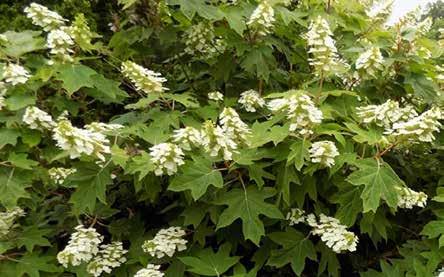
sizes from 10’ tall and wide down to 3’. ‘Pee Wee’ is an adorable mini, perfect for smaller yards or gardens. ‘Alice’ is the classic large, which is still extremely popular today for its showy flowers and highly dissected foliage.
Big leaf hydrangeas bloom on old wood at first, then repeat bloom on new wood. Oakleaf hydrangeas bloom exclusively on old wood. Prune both after the first blooms have faded, and don’t prune after July. There’s such a variety of sizes on the market today, I recommend planting the right sized hydrangea for your space so that little-to-no pruning is required.
All hydrangeas are happiest in moist, well-drained soils. For best flower-power, keep them well watered throughout the season and fertilize with a blossom-boosting fertilizer when buds are being set.



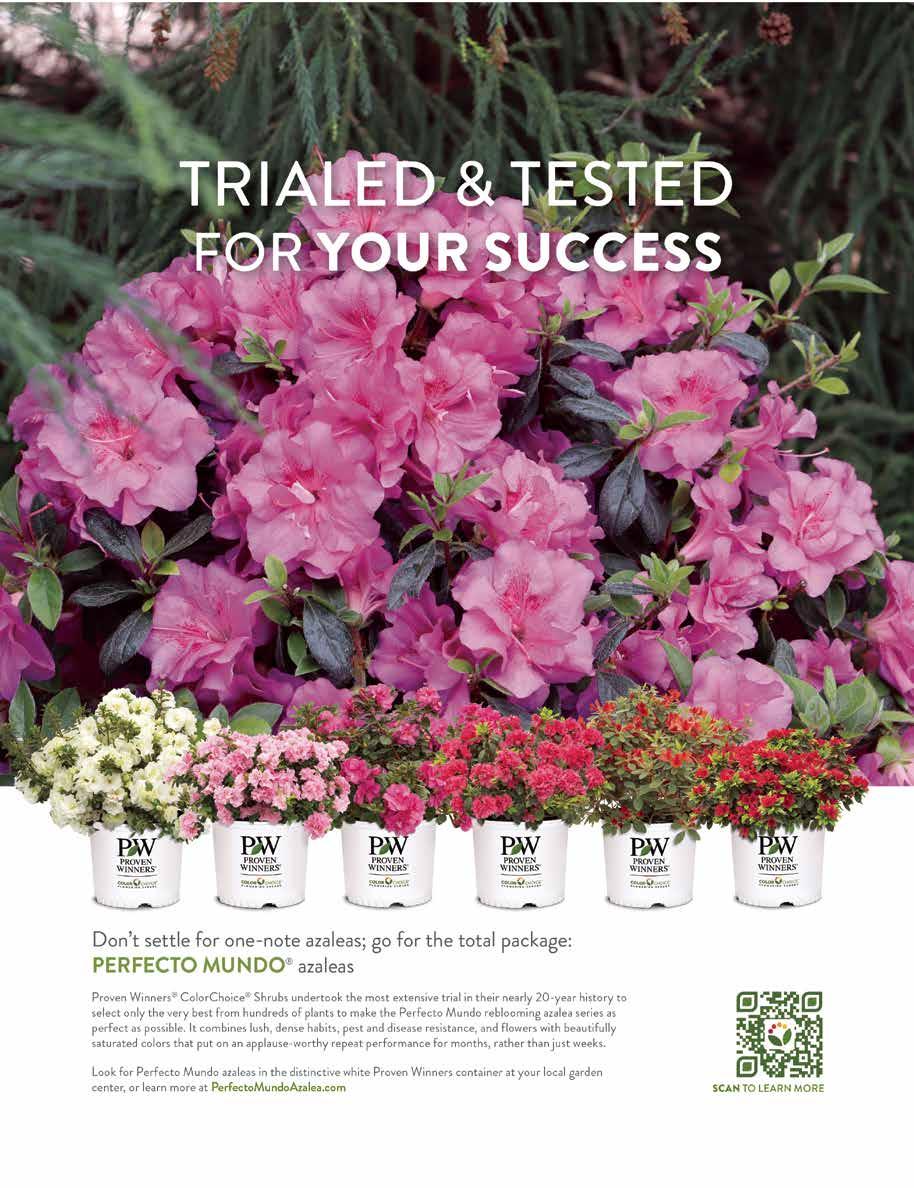




Water gardens attract more wildlife and are more fun than everyday wildflower gardens. That’s because water gardens deliver a non-stop display of dazzling wildlife. Permanent water features with native plants growing in them attract a diversity of micro-organisms like phytoplankton. They are fundamental for a thriving food chain, starting with aquatic insects, frogs, and salamanders, and ending with the occasional northernbanded water snake and snapping turtle. Let’s take a closer look.
Best water gardens include a pool of water at least 2 feet deep. Shallower than this, and the water temperature gets too warm in summer. They are easiest to build when located where water sits in the yard for days. Those places already drain poorly, because of excessive clay soil and/or compaction. Even though soils here are compacted clay, I recommend further compaction using a plate compactor (available for rent at most equipment rental stores) after digging and shaping the bottom of your water feature. Note: all small permanent water gardens are subject to leakage and evaporation, and must be refilled with water monthly.
If your soil drains well, install a thick rubber pond liner to hold water. Be sure the bottom is relatively flat so planted containers

Scott Woodbury was the horticulturist at Shaw Nature Reserve for 30 years and stepped down from that position in June 2022. He continues to work on contract for Shaw Nature Reserve to carry out native landscaping education, and has launched his own business called Cacalia: Native Garden Design and Wilding. Scott is also founder of the Wild Ones St. Louis Chapter, which financially supports this column. Find suppliers of native plants, seeds, and services at the Grow Native! Resource Guide: www.moprairie.org.
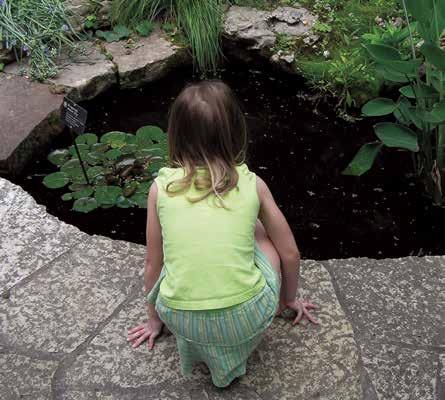
stay upright, and ring the pool with large flagstone pieces (2 to 3 feet wide) to hide and hold the pond liner edge. Also protect the liner by laying down old carpet between the soil and the liner. Carpet stores are usually willing to give away old carpet.
Water gardens should have good water circulation so that deeper, cool water gets mixed with warmer water at the surface. An aerator or waterfall will sufficiently mix the water and introduce oxygen, a key element for healthy aquatic insects and amphibians (be sure to size aerators, filters, and waterfalls appropriately). These devices will also prevent excessive algae and duckweed buildup.
Emergent aquatic plants are rooted underwater in the bottom of a soil-lined water garden (in fewer than 2 feet of water), or in submerged containers in a rubber-lined water garden. Aquatic plants are vital for a thriving aquatic ecosystem, because they provide the right habitat (hiding places) for aquatic insects that live underwater like the larvae of dragonflies, damselflies, caddisflies, and mayflies, as well as water boatmen, diving spiders, beetles that take cover in underwater and floating vegetation. Emergent stems provide “ramps” where dragonfly and damselfly nymphs can crawl up, shed their skin, and emerge as winged adults. Many of these invertebrates devour mosquito larvae—and each other—which at times is thrilling to see. I especially love seeing adult dragonflies competing for airspace. These insect predators, and their prey, add much diversity, and observing them makes water gardening so much fun.
A few favorite emergent aquatic plants include pickerel plant (Pontedaria cordata), arrow-leaf (Sagittaria latifolia), arrow arum (Peltandra virginica), wild canna (Thalia dealbaata), soft rush (Juncus effusus), and hop sedge (Carex lupulina). Floating water lily (Nymphea odorata) is recommended only for use in containers because it quickly takes over soil-bottom water gardens. Planting a diversity of aquatic species when water features are new ensures a healthy balance where all plants are equal in size and cattails won’t become a problem.
In the area just at the edge of the water, where soils are drier, best plants include copper iris (Iris fulva), orange coneflower (Rudbeckia fulgida var. umbrosa), cardinal flower (Lobelia cardinalis), rose turtlehead (Chelone obliqua), palm and fox sedge (Carex muskingumensis and C. vulpinoidea), prairie willow (Salix humilis), and in larger areas, buttonbush (Cephalanthus occidentalis) or indigo bush (Amorpha fruticosa), which grow 8-10 feet tall and wide.
Like the best things in life, water gardens take effort to maintain. Plants growing in containers need to be divided and replanted every two to three years. Leaf and debris buildup on the bottom should be scooped out every year or two. Empty the pool with a siphon in late June or July, after spring dragonflies and tadpoles have emerged, and if possible, transfer the cleanings to a nearby pond or lake (with permission). There likely are aquatic insects in the muck that can carefully be picked out and returned to the water garden.
The world is so full of wondrous things, so we should all be happy as clams in the mud. Happy gardening!
Note: some municipalities have rules pertaining to permanent water features. Read up on the requirements in your area before starting this project.
Please turn the page for a water garden design that may work for you or give you some ideas!

9814 Pleasant Hill Rd Jefferson City MO 65109 www.mowildflowers.net mowldflrs@socket.net 573-496-3492, fax: 573-496-3003
Meet us at one of these locations in St. Louis. Give us your order by Tuesday before a sale, and we will bring it to the location.
Kirkwood Farmer’s Market, 150 East Argonne Dr. Kirkwood MO 63122. Give us your order by Tuesday before a sale, or pick from the selection at the market. April 6, 13, 20, 27, May 25 & June 1. 8 a.m. to 4 p.m.
Beyond Housing Headquarters, 6506 Wright Way, St. Louis 63121; Native Plant Fair/Sale. April 28 (Sunday), 10 a.m. to 2 p.m.
Shaw Nature Reserve, 307 Pineton Loop Rd, Gray Summit MO 63039. Event: “Shaw Nature Reserve Spring Wildflower Market,” May 4, 9 a.m. to 1 p.m. Member’s only sale Friday, May 3, 3 p.m. to 7 p.m. www.shawnature.org.
Now OPEN at our Brazito (Jefferson City) location.
a Orange Coneflower (Rudbeckia fulgida var. umbrosa) (7 plants)
b Cardinal Flower
(Lobelia cardinalis) (6 plants)
c Golden Groundsel (Packera aurea) (18 plants)
d Red Buckeye (Aesculus pavia) (1 plant)
e Marsh/Swamp Milkweed (Asclepias incarnata) (5 plants)
f Switchgrass (Panicum virgatum) (3 plants)
g Marsh Blazingstar (Liatris spicata) (5 plants)
h Beautyberry (Callicarpa americana) (1 plant)
i Aromatic Aster (Symphyotrichum oblongifolium) (5 plants)
j Southern Blue Flag Iris (Iris virginica) (3 plants)
k **Leather Flower (Clematis versicolor) (1 plant)
l **American Bittersweet (Celastrus scandens) (1 plant)
m Pennsylvania Sedge (Carex pennsylvanica) (8 plants)
n Foxglove Beardtongue (Penstemon digitalis) (3 plants)
o Buttonbush (Cephalanthus occidentalis) (1 plant)


p Shining Bluestar (Amsonia illustris) (1 plant)
q Prairie Dock ( Silphium terebinthinaceum) (3 plants)
r *Pickerelweed (Pontederia cordata) (3 plants)
s *Arrowhead (Sagittaria latifolia) (3 plants)
t *Fragrant Waterlily (Nymphaea odorata) (3 plants)
* in submerged pots
** vines on fence

Q - My pine tree has borers. What can I spray to get rid of them and save my tree?
A - This is woodpecker damage, not borers. The woodpecker is the yellow-bellied sapsucker. Notice that the holes are in rows and columns. Borer damage is random. Yellow-bellied Sapsuckers have been found drilling sapwells in more than 1,000 species of trees and woody plants, though they have a strong preference for birches and maples. They make two kinds of holes in trees to harvest sap. Round holes extend deep in the tree and are not enlarged. The sapsucker inserts its bill into the hole to probe for sap. Rectangular holes are shallower, and must be maintained continually for the sap to flow. The sapsucker licks the sap from these holes, and eats the cambium of the tree too. New holes usually are made in a line with old holes, or in a new line above the old. Sapsuckers will return to the same tree year after year during their spring and fall migrations, and they will bring their offspring with them who will also return year after year and bring their offspring.

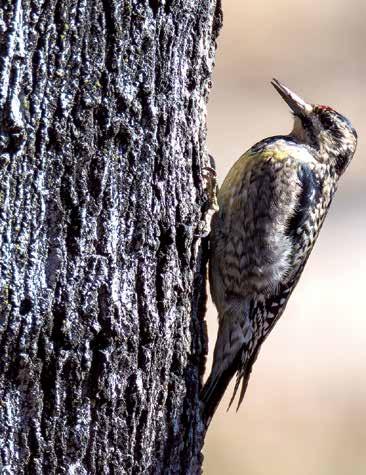
sapwells. Repeated attacks can weaken a young tree, but sapsuckers are federally protected birds and cannot be harmed. Still, there are ways to discourage them. See the Missouri Botanical Garden’s factsheet on Nuisance Birds.
2. Q - My cedar tree has holes in it and the bark is popping off. Could borers cause this? And how can I cure it?
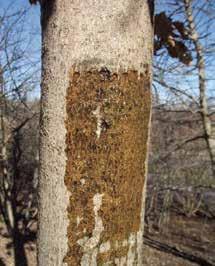
Their sapwells attract hummingbirds, which also feed off the sap flowing from the tree. In some parts of Canada, Rubythroated Hummingbirds rely so much on sapwells that they time their spring migration with the arrival of sapsuckers. Other birds as well as bats and porcupines also visit sapsucker
A - Yes, the holes in this juniper appear to be the exit holes of borers. Note: the random pattern of the holes. This same random pattern is evident in the honey locust. Since our native borers usually prefer to attack weakened trees, good cultural practices that promote tree vigor and reduce the incidence of disease can help minimize infestations and the resulting damage. Such practices include preventing injury to young trees, watering during dry periods, and appropriate pruning techniques (avoid topping your trees). These two trees may be too far gone, but if the tree is a valuable tree, consult a certified arborist for insect identification, evaluation and treatment.
Note: borers can be the larval stage of either beetles, moths, or sawflies. Each may require different control measures, so it is important to identify the borer before deciding how to treat it.
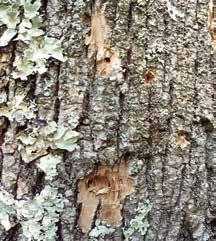
An example of random holes as well as woodpecker damage to bark from birds foraging for borers.
Do you have a gardening or plant questioin? St. Louis Master Gardeners can help find the answer. Call the St. Louis Garden Hotline at (314) 400-7657 or email: STLgardenhotline@gmail.com
Please see Ronda Anson’s bio on pg. 21.

Summer veggie season is right around the corner! Here we are going to talk about getting your veggie garden started and popular tomatoes and peppers that are staples in the garden.
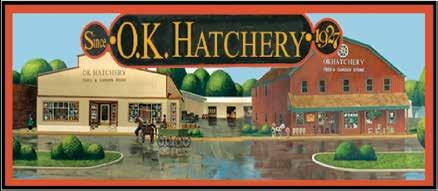
There are two ways people procure their plants in preparation for starting a veggie garden. One favorite option is to start seeds, which typically in the St. Louis area need to be started by the end of February to make sure they are mature enough to be planted in May. At this point, don’t worry if you missed starting your seeds because May is a perfect time to purchase seedlings and bedding plants. There are so many options available at garden centers, so be sure


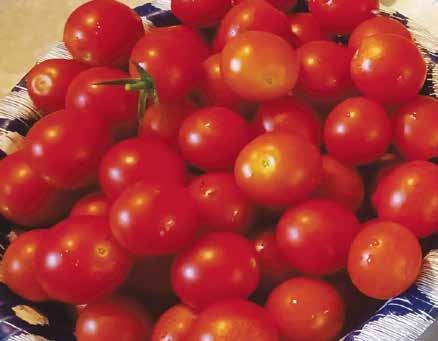
Super Sweet 100s (above) are a great variety to grow for sweet, bite-sized tomatoes that keep coming right up to frost! Right, Pablano peppers are a mild chile pepper perfect for stuffing.
to talk to those folks for their recommendations. But here we are going to talk about a few particular tomatoes and peppers that are popular and hold up well with how extreme St. Louis summers can be: Super Sweet 100s tomatoes, Celebrity tomatoes, Roma tomatoes, Jalapeno peppers, Hungarian Wax peppers, Sweet Banana peppers, and Poblano peppers.
Tomatoes and peppers such as these can do well in containers, but they often do the best in the ground with more room to grow, this is particularly the case for Super Sweet 100s. Because this type of tomato tends to grow vigorously, almost wild, and needs a lot of space. This is called an indeterminate growth habit and does require a bit of maintenance to optimize fruit production as opposed to determinate tomatoes that can be more manageable. Another important thing to practice is crop rotation, namely not planting the same thing in the same spot year after year. Amending new soil into your containers and garden beds can help with this but because issues can stem from pathogens in the soil, just adding in new soil can’t always fix it. There are a number of problems that can come from this


but specifically for tomatoes certain fungi can linger in the soil for a number of years, which will impact fruit production among other issues.
Tomatoes are part of the Solanaceae, the nightshade family which includes potatoes and eggplants, so crop rotation is particularly important for this family with these being commonly used in gardens. When planning your veggie bed, it’s important to practice crop rotation, amend soils for added nutrients, and ensure the plant’s growth habit will work for your space.
Why are these seven veggies popular? Super Sweet 100s are prolific red cherry tomatoes that make for a very sweet snack. Celebrity tomatoes are good reliable tomatoes for slicing onto a sandwich. Roma tomatoes are a favorite for sauces and canning. Jalapenos are also very prolific.





A Northern Parula sends its song out from an American Elm for all to
The more birds we have around us, the less anguish we’ll have within us.--Bhuwan
ThapaliyaAlthough this poetic guidance may seem “too good to be true” at first glance, many researchers today would wholeheartedly agree with the poet: watching birds is good for your health, especially your mental health. In particular, listening to bird songs has been shown overall to: a) reduce stress; b) lower the prevalence of depression, anxiety, and paranoia; c) improve happiness and feelings of joy; d) lower blood pressure and stress hormones (i.e., cortisol); and e) improve concentration. Although scholars used a variety of methods to obtain results, I’d like to point out the specifics of one study to give you a sense of how this type of research is done.
In one particular investigation, there were 1,300 participants who were asked to use a phone app titled Urban Mind to log data 3 times per day about their environment and well-being, including things like sleep quality, perceived air quality, and location details. Participants were not told that the researchers were interested in birds. Over time, this process resulted in 26,856 individual assessments of mental well-being in real time in the real world. Researchers found significant positive associations between seeing or hearing birds and better mental health—even when factors such as education, occupation, or nature elements (like water and greenery) were controlled for within the study design. And, get this —the benefits persisted for hours, even with no further bird sightings. Bottom line: There is something special about our feathered friends and us.
Perhaps the following quote by Adrian Thomas of the Royal Society for the Protection of Birds may offer additional insight here: “Birdsong would have once been the natural soundtrack to all human lives, and I do think it is embedded somewhere deep within our psyches. It is associated with spring and renewal and good times coming, which is just one of the reasons why we need to address this nature crisis and ensure that nature doesn’t fall silent.” One question that deserves closer examination in relation to birdsongs and mental well-being is this: How do bird songs
impact the human mind in such a positive way? Although the mechanisms are not fully understood as there are multiple factors at play, here are a few considerations to contemplate. I would sum up one factor this way: being present. I first learned about this concept from reading Eckhart Tolle’s book: The Power of Now (1997). The main gist of the book is that we humans tend to spend way too much time thinking about the past and future, which robs us of our present moments. Try it out: the next time you are pulling weeds in a garden bed, or strolling a city neighborhood, or hiking a trail, come to a full stop and scout out a bird. Sometimes those little chickadees are hidden in a thicket, but you can hear them just the same. Either way, you will find yourself dwelling in the present moment, guaranteed.
Another aspect about birds is that, by and large, they live outside; so, if we want to witness them, we must go outside in nature—and
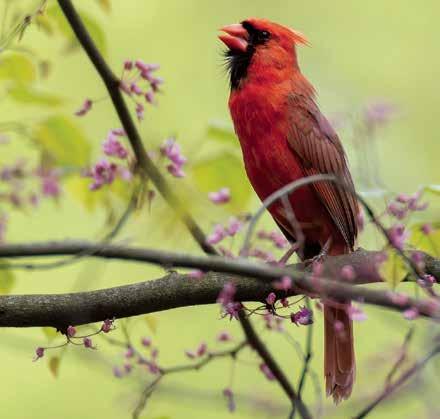
this very fact motivates us to be more physical and social—both important elements of well-being. One added bonus to being in nature is improved concentration, which lessens mental fatigue. Scholars have labeled this phenomenon “soft fascination,” meaning our attention is diverted, which allows us to mentally replenish. Sometimes, spotting a particular type of bird can strike an emotional chord, much like how a certain smell or song lyric resonates within. In my case, seeing a red-winged blackbird immediately transports me back to a special time as a young girl spending fun summers with my grandparents on their farm.
Another factor that improves mood revolves around the notion of being mesmerized: fascinated by the beauty of the situation or touched emotionally by what seems akin to love. I can vividly recall the first time I watched a male cardinal pass a safflower seed to the mouth of his female lifetime companion as they both stood in my hopper feeder during the Spring nesting season. The visual touched me deeply—I felt joy. The result was: I got hooked on birds!
Last but not least, birds are entertaining—oh, the drama of it all. It feels like you are watching a soap opera, but no electronics required! Over time, as you tune in to a particular setting, it is fun to figure out the cast of characters. I get the biggest kick out of watching my very own backyard feathered “guardians of the galaxy”: the mockingbirds. These birds perform feeder security maneuvers all day long as they fly between two feeder stations, swooping in at break neck speed and bumping off birds at one feeder only to glance up and witness “intruders” at the second feeder. This sighting prompts the mockingbirds to fly off to guard the second feeder, which sends an “all clear” message to the initial “intruders” many of whom are back at the first feeder, nibbling seeds—as if nothing happened. I delight in being a spectator.
Although there is still much to learn about the impact of birds and their songs on our health, the research is clear about one thing: birds matter—and they matter a lot. As master gardeners, we are adept at looking down at the ground to pick that perfect spot to plant a new varietal; but, maybe, just maybe, we should spend more time looking up!
Informational Sources:
Sima, Richard. Why birds and their songs are good for our mental health Well+Being, Washington Post, May, 2023.
Haupt, Angela. Birdwatching has big mental-health benefits. Here’s how to start. Time. November, 2022.
Sima, Richard. Our best brain tips for a healthier, happier life. Well+Being, Washington Post, December, 2023.
Batty, David. Bird and birdsong encounters improve mental health. The Guardian. October, 2022.
Tolle, Eckhart. The Power of Now: A Guide to Spiritual Enlightenment, 1997, Namaste Publishers, Vancouver.
Shawn Pohlman is an avid gardener and bird enthusiast, about to graduate from the Master Gardener program at Missouri Botanical Garden. She is an Innsbrook Garden Club and Community Garden member. Shawn has three degrees in nursing (BSN, MSN, PhD). Shawn has always been drawn to nature and nurture.

For those new to birding, or even long-time but casual birders like me, there are many resources out there to help us learn how to identify birds by sight and sound. Two of my favorites are the following:
Hummer Haven UnLTD
https://hummerhavenunltd.com/blog
Hummer Haven UnLTD is a blog/website hosted by Margy and Dan Terpstra, avid birders and photographers who record and write about the avian and other wildlife that visit their beautifully naturescaped plot of land in Kirkwood, Missouri. Their blog not only provides photos of the thousands of birds that find refuge in their woodlands, but frequently educates with comparisons of similar birds, discussions of anomalies, and reminders of the importance of native plants and sustainable practices beneficial to create safe and supportive habitat for the animals that live in and above it (see an example below). For more information, visit the website and subscribe to her blog.
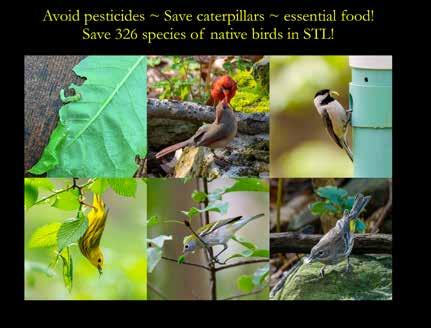
This easy-to-use app by the ornithology experts at Cornell Lab helps users id birds in a number of ways. If you see an unfamiliar bird you can enter in a few descriptive characteristics and Merlin will do its best to offer suggestions as to what bird you’ve seen. Better still, if you can get a photograph, the app will try to identify the bird that way.

But I use it most for the third option—the sounds birds are making. Small birds, especially migrant birds passing through in the spring and fall, frequently are found (or rather heard) high up in the canopies of large shade trees, heard more than seen. But turn on the Sound ID feature of the app, and suggestions will pop up as the bird songs rain down. The app filters by your location so focuses primarily on birds expected to be in your area.
You can do so much more with Merlin—create a personal bird list, participate in citizen science by sharing your birds with others, and more. But it’s the Sound ID feature that keeps it close at hand for me. Download the app from the Apple Store, Google Play or wherever you get your device apps. --Editor
The Garden Tours are coming soon! Here are the ones we’ve been notified of as of our deadline, providing plenty of opportunities to check out the area’s most interesting gardens and gather some tips to implement in your own landscape!
May 18th
9am-4pm
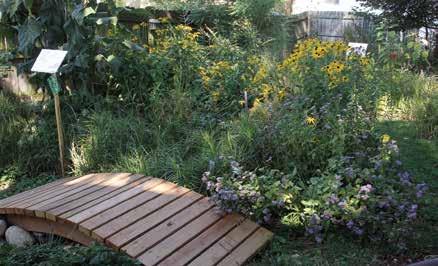

The popular St. Louis Native Plant Garden Tour is produced annually by St. Louis Audubon Society and Wild Ones St. Louis Chapter. This year, 11 gardens are in and around southwest St. Louis City and Maplewood. This self-guided tour includes a wide variety of habitats, native landscaping styles and yard sizes. This is an educational tour, so there will be a lot of information posted in gardens and shared by

the homeowners and by volunteer docents throughout the day. To register go to stlouisaudubon.org.
May 18th & 19th
9am-4pm Sat., 10am-4pm Sun.
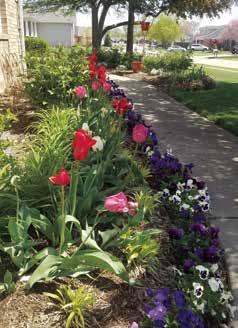
The Ste. Genevieve Master Gardeners and Missouri University Extension Spring Garden Walk and Plant Sale features tours of private and historic gardens and a Plant Sale with a variety of plants for sale that include annuals, perennials, natives, vegetables, houseplants and lily bulbs, the Ste. Genevieve’s honorary flower. Additional activities for the weekend include Saturday’s Farmer’s Market, tours of historic “poteaux en terre” vertical log homes dated to 1790. Enjoy shopping, lunch. Explore the local nature areas and wineries. Walk begins at the Ste. Genevieve National Historic Landmark District Welcome Center at 66 South Main St.
Tickets for the Garden Walk are $10.00/individual; children 6 and under free. Contact University of Missouri Extension at (573) 883-3548 or VisitSteGen.com.
Proceeds fund our “Keep Ste Genevieve Beautiful” grant program which over the past years have provided $17,000 for numerous beautification and garden education programing for our community.
May 31st & June 1st 4-8 Fri., 9am-1pm Sat.
Featuring gardens in Belleville, IL. Tickets available at Sandy’s Back Porch, Effinger’s Garden Center, Dintelmann’s Nursery & Garden Center, and O’Fallon Ace Hardware. For more information contact U. of I. Extension (618) 939-3434 or ruth1@
The Garden Tour includes both a walking tour of gardens in downtown Historic Hermann and a driving tour to gardens in the hills around Hermann. The $15 ticket price includes visits
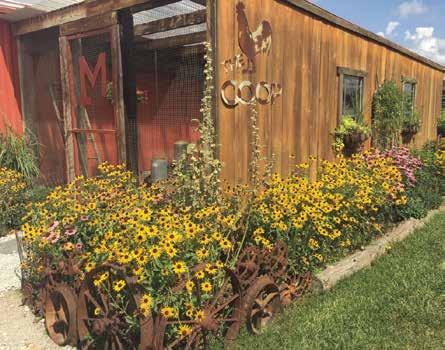
to at least five private gardens; these gardens are both in town and in the country and include a traditional four-square garden. Garden Tour visits may be spread over Saturday and Sunday. Tickets will be sold online before the tour at Eventeny and at Topiaries (138 E. 4th) in downtown Hermann during the tour from 10-4 on Saturday and 10-3 on Sunday. Gardens close at 5PM on Saturday and 4PM on Sunday. A map to the gardens will be provided starting on Saturday June 3rd at the Topiaries ticket sale site; those who pre-purchase tickets will pick up the map at that time as well. The Hermann Garden Club’s website www. hermanngardentours.com provides up-to-date events, ticket prices, links to the online ticket sale site, contact numbers, and photographs of past tour gardens. A special new event, The Garden Club Yard Sale, will begin at 10am on Friday, May 31st at the Rotunda in Upper City Park and continue
until 6pm. There will be a preview from 3-6pm on Thursday, May 30th; tickets for the preview are $10. Visit the FAQS page on the website for answers to all your questions. “Like” us on Facebook at “Hermann Garden Tours.”
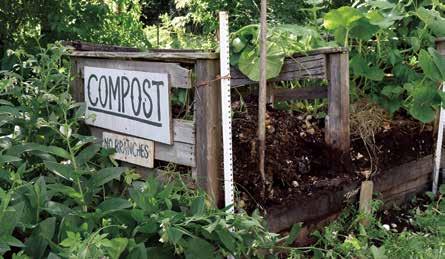
A unique opportunity to see firsthand how homeowners in the St. Louis region are transforming their yards into heavenly havens of green. With dozens of stops in municipalities and neighborhoods throughout the region, this year’s tour will showcase a range of green living practices, including low-impact lawn care, composting and using recycled materials creatively, organic cont’d on mext page


gardening, chicken and beekeeping, gardening with native plants, cultivating mushrooms, fruit and nut trees, as well as rainwater conservation, pesticide and herbicide reduction, renewable energy production and backyard habitat creation.
“This free, self-guided tour opens the gates to private yards and gardens so that attendees can ask and learn, pick up new ideas, and share inspiration,” says Terry Winkelmann, Founding Director of The Sustainable Backyard Network, the tour’s producer. Tour goers design their own routes, choosing the listings nearest their own home or their own interests.
Residents will open their yards, patios and balcony gardens to share how they have incorporated sustainable strategies to grow food, support biodiversity, conserve and manage rainwater and even generate energy. “This is not the tour of the designer show garden,” said Winkelmann. “This is the real-world application of organic, sustainable and beautiful ideas that will leave you saying, ‘I can do that!’”
Visitors who register to attend through the website or Eventbrite, will receive the listings of properties on the tour and set their own route. Guests can plan their tour around neighborhoods or special interests like permaculture, beekeeping, backyard chickens or solar power.
The event is free but registration is required.
June 22nd & 23rd 9am-5pm
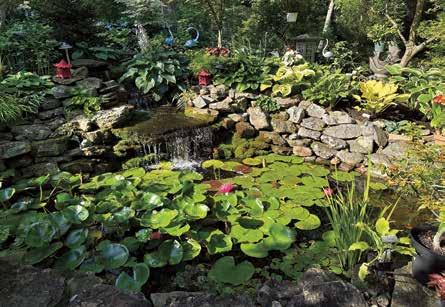
The St. Louis Water Garden Society (SLWGS) is celebrating 34 years as a society sharing information about fish, ponds, and gardens. The 2024 tour will feature 24 private water gardens owned and maintained by Society members. Tickets covering both days of the tour are $20 each (18 and older) and will be available at local retail shops and garden centers throughout the metropolitan area or on our website. A special 2024 Discount: Groups of 5 or more are only $15 each. The gardens are located throughout the St. Louis metropolitan area, two in Illinois and twenty-two in Missouri. This self-guided tour is arranged each day by geographic location. This year there are many new members who are excited to share their new ponds
and waterfalls. The ticket books this year are in full color, with pictures of each host location, descriptions of the water features, directions, and QR codes to each location.
There are always many varieties of water gardens, bubbling rocks, small ponds to massive ones. Many members are master gardeners, and many water gardens have been featured in St. Louis Homes and Lifestyles Magazine and local newspapers and magazines.
Our hosts will be available and delighted to share information and answer questions about their gardens, their water features, their fish, and their beautiful plants. If you are thinking of adding water to your own garden—or you can simply just enjoy the beautiful landscapes and a weekend filled with beauty—this is the tour for you!
This event provides funds for the St Louis Water Garden Society to continue their civic project to plant and maintain the reflecting lily ponds at the Jewel Box in Forest Park. Society members for 34 years work each Saturday at the ponds from May-October to keep the lily ponds looking beautiful.
For more information on where to purchase tickets by mail order from the Society’s website in May, www.slwgs.org, and at many of our retailers and garden centers.
June 23rd 1-4pm
New Town Garden Club Annual Garden Tour
Tickets $10.00 in advance. Start at Town Hall in New Town, St. Charles. Home gardens that use small space for a big impact. Purchase tickets by contacting Terri Steffes at terristeffes1117@ gmail.com with Venmo.
June 29th & 30th
9am-Noon
Open Garden
Beautiful yard full of flowers. Daylilies, Hosta, Hydrangeas, Water feature and a lot more. Address: 2 Bridgers Pass Court St. Peters, MO 63376.
May is the biggest gardening month because the weather finally leaves the season of cold snaps behind and provides consistent warm temperatures and sunny days. Young plants are now safe to grow outside, the soil warms with longer days and higher temperatures and gardeners are encouraged to plant, plant, plant! Plant seeds, plant roots, plant young plants, just get out and plant.

So the biggest question is what to plant! The number one answer is Tomatoes! Even my daughter who doesn’t eat tomatoes, nor does she actively garden, plants tomatoes. The next question is which tomatoes (note: it’s always plural because one tomato plant is never enough).
There are so many choices. The main categories are based on how they are used; “slicing”, “sauce”, “salad” and “snacking”. This is helpful but it merely is determined by size and shape of the fruit. Sometimes it’s the size and shape of the plant that makes it successful in a particular garden setting. Most springs I have the opportunity to plant a small veggie garden with my granddaughters in Boston. It’s in their neighborhood park. Here I plant climbing cherry tomatoes that the children of the neighborhood can pick for a “snack”. To entice their interest, I choose a small red cherry called ‘Super Sweet 100’s’, the pretty orange ‘Sun Gold’ and the fun ‘Yellow Pear’ tomato. In my own garden I plant these plus ‘Queen of the Night’ with black stripes, ‘Pink Thai Egg’ and ‘Purple Red Cherry’. These I grow at the corners of my garden on upside down tomato cages with the legs wired together at the top to make a cone. These would all be climbers used for snacking!
Two of my daughters plant a single tomato in a pot, dreaming of picking a juicy ripe tomato for a salad in the evening after a long day of work. They share this experience with their children like I did with them, just on a much smaller scale. For them I recommend a determinate, or bush style tomato plant that produces “salad” size fruit. ‘Goliath’, ‘Bush Early Girl’ and ‘Celebrity’ are perfect for their needs.
My other daughter is an enthusiastic gardener in an urban setting. She has small raised beds in U. City and enjoys cooking with her precious harvest. She likes ‘Principe Borghese’, ‘Amish Paste’, ‘San Marzano’, and ‘Vivacious’ to make sauce or to dry in her dehydrator.
I am the extreme tomato grower, with a large garden of raised and deeply cultivated beds in the country. I plant 5 rows of 9-10 plants each surrounded by “pig wire” fencing to create large cages only 12” wide by 20’ long. I plant 3 each of 15 varieties; ‘Missouri Love Apple’, ‘Brandywine’, ‘Paul Robeson’, ‘Golden Jubilee’, ‘Amana Orange’, ‘Dr Wyche’s Yellow’, ‘Hungarian Heart’, ‘German Johnson’, ‘Mortage Lifter’, ‘Rutgers’, ‘Black Krim’, ‘Black Beauty’, ‘Pineapple’, ‘Orange Jazz’, ‘Green Zebra’ and ‘Granny Cantrell German Red’ are favorites for my garden. I plant tomatoes for slicing, canning, to serve at our winery events, to make salsa with bright colors and to display as works of art! I garden not just for purpose but for passion because I love producing wonderful vegetables to share!

Steffie Littlefield is a St Louis area horticulturist and garden designer. She has degrees from St. Louis Community College at Meramec and Southeast Missouri State and is a member of Gateway Professional Horticultural Association, Missouri Botanical Garden Members Board and past president of the Horticulture Co-op of Metropolitan St. Louis. She is part-owner of Edg-Clif Winery, Potosi, MO. www.EdgClif.com, and teaches a class on viticulture at SLCC-Meramec.

(ED. NOTE: Because of the extremely warm weather we were experiencing in midApril as we were preparing this issue for print, there were news reports that the Brood XIX cicadas might actually start emerging in mid-late April, nearly a month ahead of schedule. Regardless since they will be around for 5-6 weeks, we think you’ll still find this article informative and timely.
Every summer male dogday cicadas serenade female cicadas with their love songs. Although not the intended objects of their wooing, we hear them too, reminding us that summer break is coming to an end and it’s time to buy school supplies again. This year the serenade will begin much earlier, reminding us that the summer break is only just starting. Most of Missouri will experience the return of cicada Brood XIX, also known as The Great Southern Brood. Every 13 years they assault the eardrums of the residents of Missouri, Illinois, and many southern states. Brood XIX will emerge when the soil temperature at 8 inches deep reaches around 64 degrees F (late May, early June) and will be around for 5 or 6 weeks. Cicadas live on tree roots for all but their final weeks of life. So, areas without trees, such as new developments where all the trees have been removed, will not see any kind of cicada.


already died immediately after mating. Eggs hatch after 6 to 7 weeks, and the newly hatched nymphs fall to the ground, burrow until they find a suitable tree root, and begin feeding. They won’t be seen above ground for another 13 years, in 2037.
Within days of egg-laying, the twigs containing the eggs start to dry out and die. This dieback is called flagging and will be seen this summer on many trees and shrubs. Established trees and shrubs can usually tolerate losing a portion of their new growth, but smaller trees and shrubs have fewer branches on them, and egg-laying can cause significant damage to them. So, this spring or early summer is probably not a good time to plant a small tree or shrub, unless they are protected.
This year, Illinois is facing the simultaneous emergence of two broods: the 13-year Great Southern Brood (the same brood Missouri is expecting) and the 17-year Northern Illinois Brood (the most populous brood). It’s the first time since Thomas Jefferson was president that both are emerging the same year. Thankfully, they only overlap in a narrow band north of Springfield, Illinois. In expectation of this state-wide cicada emergence the University of Illinois Extension advises the following:
Although adult cicadas do not eat, or at least not enough to cause any noticeable damage, the females can significantly damage young trees and shrubs, not by eating them, but by laying their eggs in them. Their targets are twigs or branches about the thickness of a pencil or a bit thicker, which includes most new growth on trees and shrubs and almost all branches on very young trees and shrubs. The female cicada digs her ovipositor (egg-laying organ) into a twig and cuts a slit in the wood, in which she deposits up to 10 eggs. Then, she steps forward and does it again. One female can lay as many as 400 eggs (some sources say 500-600). Then, she dies (presumably of exhaustion). Her male suitor
• Avoid planting trees and shrubs the year before a periodical cicada emergence [too late for that]. Avoid planting trees and shrubs in the spring of an emergence year, too. If you do need to plant, choose plants that have a stem diameter of at least 2½ inches in diameter.
• Place netting around small trees and shrubs, making sure it is secured around the base of the plant to prevent cicadas from crawling up the plant from the ground. The opening should be no larger than ¼ inch. It may be helpful to build a frame around the plants, cicadas may still be able to lay eggs on branches that are touching the netting.
• Twigs and branches that have had eggs laid in them can be pruned off to prevent the nymphs from reaching the ground and feeding. However, feeding by cicada nymphs does not seem to be harmful to the trees they feed on.
• Insecticides are not recommended to manage periodical cicadas in home landscapes. Large, healthy trees are able to survive egg-laying with no long-term impacts (this has been
happening for thousands of years). Insecticides are not as effective in protecting smaller trees and shrubs from cicadas as netting. Additionally, applying pesticides to control cicadas may harm other organisms, including animals that eat cicadas.
Side Note: Cicadas are NOT locusts. While locusts can chew up plants, cicadas can only suck up liquids. Locusts (as in “a plague of locusts” from the Bible) are a kind of grasshopper that still exists and is wreaking havoc in parts of Asia and Africa. True locusts are extinct in North America. The last sighting of the Rocky Mountain locust was in Canada in 1902. A close relative of the locust, a kind of flightless katydid called the Morman Cricket, still exists in the Western states, and the alfalfa cricket, another close relative, was still devasting crops in Oklahoma in 2023. But cicada Brood XIX is no plague of locusts. Cicadas cannot chew.
Ronda Anson has been an enthusiastic gardener since 1995. She is certified as both an Illinois Master Gardener and St. Louis Master Gardener. She was a longtime Horticulture Answer Service and Plant Doctor volunteer at Missouri Botanical Garden and quickly developed an expertise in the world of insects. She continues to teach Insect ID classes on a regular basis to master gardener trainees and the general public. In 2019 she was asked to set up and coordinate a gardening answer service for MU Extension - St. Louis county. Thus, the St. Louis Garden Hotline, staffed by St. Louis Master Gardeners, was born and where visitors and their diseased plants are welcome. Call the St. Louis Garden Hotline at (314) 400-7657 or email: STLgardenhotline@gmail.com.

Sunday, June 30
11 a.m. to 4 p.m.
Don’t miss the Sustainable Backyard Tour! Explore eco-friendly spaces throughout the St. Louis region for FREE! Talk to organic gardeners and beekeepers. Pick up tips on stormwater management, renewable energy and more. Learn about wild edibles, soil building, and our native plants and animals.





Wendi Martin, a holistic horticulturist and master naturalist, wife, and mother of two is excited to announce a new local business, Purple Martin Coaching, LLC. Wendi is offering gardening expertise from her past decade of learning and working the many facets of our local green industry. Her services include resilient garden coaching, ecological landscape and land tract consultations, edible and native garden design, even garden sitting. Her clients are DIYers and stewards of their landscapes who want to take good care of their gardens, but may be lacking in time, experience, knowledge or sufficient well-being.
Wendi is a graduate of the St. Louis Community College-Meramec with an Associates Degree in Horticulture. She has also supplemented that education with an apprenticeship at Earthdance Farms, in Ferguson, MO. That experience introduced her to practices of stormwater management, the value of Missouri native plants and the importance of pollinators in general and specifically for the food crops they were growing on the farm.
She is also a certified Master Naturalist and has completed an Internship with Litzsinger Road Ecology Center, managed by Missouri Botanical Garden, where she learned land tract stewardship including methods in monitoring, managing and restoring Missouri tallgrass prairie, woodlands, and streambanks.
Wendi’s work has taken her through experiences as a Horticulturist for municipal parks and recreation, for private estates, and through wholesale growing supplies and plants for retail departments of our local green industry. She is a professional member of Grow Native!, GPHA(Gateway Professional Horticulturist Association), and also serves as a board member for St. Charles Area Wild Ones and Landscape and Nursery Association of Greater St. Louis
Wendi is now applying her education, experience and enthusiasm for the green world toward clients’ needs, coaching residential community members and land owners to foster resilient and functional landscapes and thus meet clients where they are in order to guide them to be their own best garden and land stewards. You can reach her through purplemartincoaching.com or at (636) 442-3836.

Updates to this information are often posted on our online events calendar at www.GatewayGardener. com, so check there for the latest details.
Give us the details of your upcoming gardening, lawn or landscaping event and we’ll add it to our website and include it in our next issue. Deadline for printing in the September issue is August 1st.
How to reach us: Mail: PO Box 220853, St. Louis, MO 63122
Email: info@ gatewaygardener.com
May 4th
9am-Children’s Garden Club. Mother’s Day Baskets and Planting Veggies. Queeny Park –Nursery #1, 1675 S. Mason Rd. (Queeny Park East Entrance), St. Louis 63131. FREE. Pre-registration is required on the St. Louis County website at https:// tinyurl.com/yc3v3pfj or by calling 314-615-4386.
June 1st 9am—Children’s Garden
Club. Chickens. FREE. Queeny Park – Nursery #1, 1675 S. Mason Rd. (Queeny Park East Entrance), St. Louis 63131. FREE. Preregistration is required on the St. Louis County website at https://tinyurl.com/yc3v3pfj or by calling 314-615-4386.
May 2nd 6pm—Spring Plant Fashion Show. Passiglia Landscape, Nursery & Garden Center, 1855 MO109, Wildwood, MO 63038. (636) 458-9202, passiglia@ passiglia.com. Passiglia.com.
May 3rd&4th
3-7pm Fri. (members only), 9am-1pm Sat.—Spring Wildflower Market. Shop from a wide selection of Missouri native wildflowers, grasses, shrubs, vines, sedges and trees suitable for all conditions and grown by local nurseries in the region. Talk to native plant experts and enjoy beer, wine, spirits, cheese, honey, crafts and more. Shaw Nature Reserve.
May 4th
10am—Petite Planters
Event. Passiglia Landscape, Nursery & Garden Center, 1855 MO-109, Wildwood, MO 63038. (636) 458-9202, passiglia@passiglia.com. Passiglia.com.
May 9th
6-7:30pm—Bin Systems
Part of the Composting Class
Series hosted by Seed St Louis, Table to Garden, and Willoughby Heritage Farm. The first four Core classes cover basic composting principles, soil health, and how to select a compost system(s) that works for you and your family. Thereafter starting in May, monthly Specific classes cover indepth information and handson skills for compost bin systems, vermicomposting (worm composting), compost tumblers, Bokashi fermentation, and static compost systems. Wrap up the series with a microscopic examination of compost samples and free potluck dinner in October! All classes will be held at the new Compost Demonstration site at Willoughby Heritage Farm, 631 Willoughby Lane, Collinsville, IL 62234. Classes are $12/ea. Visit https://bit. ly/3GE34ws for more information and to register.
May 11th 10am-5pm—Washington County in Bloom Flower Festival. Seed and plant swap. Craft and Plant booths, workshops, food trucks and more. Forshana Farm, 16270 W. State Highway 8, Potosi, MO. Visit WashCoFlowerFestival.com for more info.
May 11th 10am-2pm—Native Plant Sale. Presented by Grow Native! World Bird Sanctuary. 125 Bald Eagle Ridge Rd., Valley Park, 62035. Entry fee to World
Bird Santuary is $8/car for one adult, $12/car for multiple passengers.
May 11th
9am-noon—Annual Plant Sale at Longview Farm Park. 13525 Clayton Road 63131. Perennials and native plants from Longview gardens and members own gardens Questions? Contact Claire Chosid at claire@ chosid.us or 314-479-3156. Cash or checks, only please.
May 11th
9am-noon—Kirkwood Garden Club Plant Sale
Featuring a variety of native plants, perennials and potted plants. Kirkwood Train Station, Kirkwood, MO.
May 18th
10am-3pm—Plant America
Garden Expo. Weldon Spring Interpretive Center, 7295 S. Highway 94, St. Charles, 63304. Activities for kids, speakers and demonstrations, information on gardening, nature and sustainability, vendors with plants, vegetables, herbs, and crafts. Food trucks. (314) 750- 1373 (call or text).
May 18th
9am-4pm—St. Louis Native Plant Garden Tour. See details on page 16.
May 18th & 19th 9am-4pm Sat., 10am-4pm Sun.—Ste. Genevieve Master Spring Garden Walk and Plant Sale. See details on page 16.
May 25th
9am-5pm—66th Annual African Violet Show & Sale. “Rainbow of Violets.” Presented by the Metropolitan St. Louis African Violet Council. Horticulture-Design exhibits, educational info and supplies. African violets and other gesneriads. Area growers will be on hand to give plant care advice and share information about this organization. Open to the public and free with Garden admission. Missouri Botanical Garden, 4344 Shaw Blvd., St. Louis 63110.
May 26th 1pm—Annuals vs. Perennials: Choosing the Perfect Plant. Passiglia Landscape, Nursery & Garden Center, 1855 MO109, Wildwood, MO 63038. (636) 458-9202, passiglia@ passiglia.com. Passiglia.com.
May 31st & June 1st 4-8 Fri., 9am-1pm Sat.— Gardens in Bloom Tour. See details on page 16.
June 1st & 2nd
10am—29th Annual Town and Country Garden Tour. See details on page 17.
June 5th
10am—The Language of Flowers Class. Passiglia Landscape, Nursery & Garden Center, 1855 MO109, Wildwood, MO 63038. (636) 458-9202, passiglia@ passiglia.com. Passiglia.com.
June 6th & 7th
Noon-5pm Thurs., 9am-3pm Fri.—”Explore St. Louis”, a Small Standard Judged Flower Show. Hosted by The Garden Appreciation Club of Greater St. Louis and the Forsythia Garden Club. See specimens from garden club member’s gardens along with beautiful arrangements interpreting St. Louis’ famous landmarks and destinations. Open to the public in Meeting Room 2 at the St. Louis County Library Thornhill Branch, 12863 Willowyck Dr, St. Louis, MO 63146.
For more June Garden Tours, please see pages 17-18.

Master Gardener Speakers Bureau volunteers are available to speak to garden clubs, church, civic and other groups. Choose from 53 programs, including A Dark Side to Winter Damage, Backyard Composting, Soil Preparation, Daylilies, Orchids, and more. Explore the complete list of topics at www.stlmg.org. Look for the Speakers Bureau tab in the top margin.
(A $50 fee funds Master Gardener programming in our community.)


• Garden Centers and Nurseries
• Garden Gift and Accessory Shops
• L & G Tool and Equipment Sales/Rental/ Service
• Landscape Building Material Centers
• Outdoor Living Furnishing Centers
• Wild Bird Centers
• Farmer’s Markets
Professional Landscape Services
• Arborists
• Landscape Maintenance Specialists
• Interior Plantscape Specialists
• Irrigation Contractors
• Landscape Contractors
• Landscape Designers
• Landscape Lighting Specialists
• Lawn Care Services

• Swimming Pool Design/ Installation/Service Specialists
• Water Garden Specialists
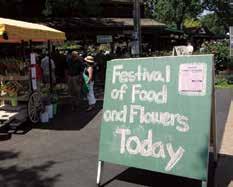
• Landscape Building Products • Plant Health and Nutrition
• Plant Marketing Programs • Home and Garden Tours
Garden Club Plant Sales

